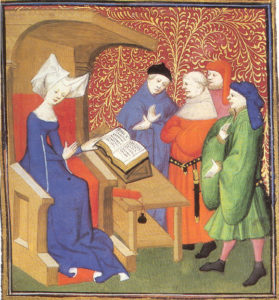
Christine de Pizan lecturing men. From compendium of Christine de Pizan’s works, 1413. Produced in her scriptorium in Paris. British Library.
Christine de Pizan (1365 – 1430) was an Italian writer at the French court during the Hundred Years War between England and France. She is considered the first professional female writer.
Christine moved to Paris at the age of 5. Her father, Tomaso, had already moved to Paris to become the court astronomer to King Charles V of France. Once he was established he moved the rest of his family. Christine was given the opportunity to be educated along with her brothers, and she had access to the incredible library of Charles V, which numbered over 1200 volumes on his death. This was a unique opportunity for a women in this time, and Christine developed a sense of how important learning and books were.
At 15, Christine married Estienne de Castel, and the couple had three children. Estienne was an educated and successful man, who was court secretary in France. The couple had a happy marriage until Estienne died 10 years later, leaving Christine a widow at 25. Around the same time, Christine’s father and King Charles V of France died; in a short space of time Christine lost all of her male protectors. With three young children to support, Christine was left in a dire financial situation, partly due to the difficulty of accessing deeds which had been left to her.
Christine began writing lyrical poetry about the grief of being a widow, which soon attracted the attention of royal and aristocratic patrons, such as Louis of Orleans. While she had originally written her poetry to express her personal grief rather than for financial gain, once she received recognition for her writing she continued to write and manage to please opposing factions at the French court, led by the Duke of Orleans and the Duke of Burgundy.
Her most famous piece of work is arguably her book titled The Book of the City of Ladies. Published around 1405, it is often credited as the first feminist text written by a Western woman. It was a response to Jean de Meun’s Roman de la Rose. In her book, Christine defends de Meun’s criticism of women by building her allegorical city of ladies; she used a variety of historical and contemporary women, each of whom make up a building block in her city. She discusses numerous women in her book including Blanche of Castile, Sappho, Isis, the Queen of Sheba, Theodora, and Isabeau of Bavaria. Her book also promotes education for women.
Christine was fairly unique to have such a good education at a time when it was thought unimportant for women to be educated. Had her husband lived, it is unlikely she would have pursued a career as a writer, but circumstances meant she needed to support her family. As a writer she supported other women, and was influential in attempting to change society’s perceptions of women by using real life examples of incredible women.
